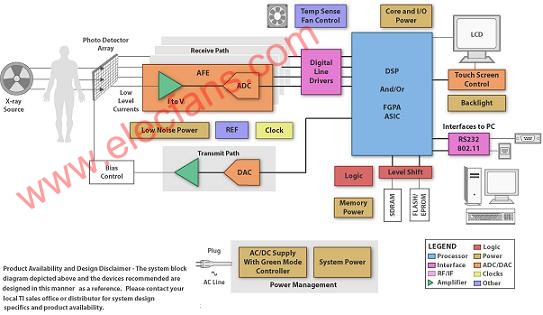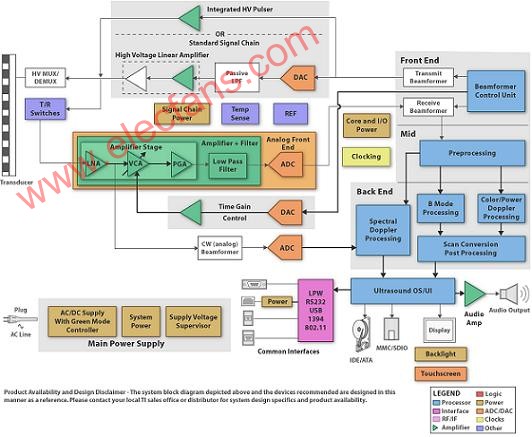This article will introduce the many challenges and latest developments in electronic design of different imaging methods, including digital X-ray, magnetic resonance imaging (MRI) and ultrasound systems.
Digital X-ray system
Traditional X-ray systems use a film / screen device to detect X-rays emitted into the human body. However, the digital X-ray signal chain in the detector system contains a photo detector array that converts the radiation into electrical charges. It is followed by some charge integrator circuits and analog-to-digital converter (ADC) circuits to digitize the input. Figure 1 shows an example of a typical digital X-ray system block diagram.

Figure 1: An example of a digital X-ray system structure diagram.
The performance of the digital X-ray system is closely related to the noise performance of the integrator and ADC module. In order to obtain higher image quality under low power consumption, the degree of electronic integration required to support a large number of signal channels in a system sets a certain standard for technological innovation. It is because of the many high-performance analog components that make up the detector system and the embedded processor that performs advanced image processing tasks that the X-ray system has many advantages over traditional X-ray systems. This combination supports a greater dynamic range, which results in better image contrast and lower patient X-ray radiation levels, while producing digital images that can be electronically stored and transmitted.
Ultrasound system
The receive channel signal chain of the ultrasound system includes a low-noise amplifier (LNA), a variable gain amplifier (VGA), a low-pass filter (LPF), and a high-speed high-precision ADC. Following these components are digital beamforming, image and Doppler processing, and other signal processing software (see Figure 2).

Figure 2: An example of an ultrasonic system structure diagram.
The noise and bandwidth characteristics of the signal chain components define the overall upper performance limit of the system. [1] In addition, while dissipating lower system power, more high-performance channels need to be integrated in a smaller area. A typical handheld ultrasound system may have about 16 to 32 channels, while some high-end systems may have more than 128 channels to obtain higher image quality. To reduce the printed circuit board (PCB) that occupies all these array channels, the focus is to integrate as many channels as possible in the analog front-end IC. The total system power consumption is another important performance index for handheld systems. Integrating the receiver electronics directly into the probe is another aspect of innovation.
Doing so helps shorten the distance between the low-voltage analog signal source and LNAs in the probe, thereby reducing signal loss. Integration will further increase the number of probe pieces, thereby enhancing 3D imaging. In addition to these analog signal chain considerations, high-performance, low-power embedded processors can complete beamforming and image processing tasks for portable devices faster and more efficiently than before.
For an example of a typical MRI channel analog signal processing chain, see Figure 3.

Figure 3: Example of MRI system structure diagram.
A whole-body MRI system may have a coil matrix of up to 76 elements or channels. In addition, a low-voltage (LV) analog input is transmitted from the limb coil to the analog signal chain preamplifier along a long coaxial cable. When it comes to the MRI receive signal chain, two key points follow: how to obtain a high signal-to-noise ratio (SNR) (at least about 84dB or 14 bits); how to achieve the extremely high total dynamic range of the total system (at least about 150dB / Hz) ). Obtaining high SNR requires a high-performance preamplifier with ultra-low noise figure. The use of innovative solutions such as dynamic gain adjustment or analog input compression can achieve high dynamic range requirements.
In short, by increasing the number of coils used in the MRI system, not only can obtain a better image range, but also can shorten the image scanning time. The increase in the number of coils may require further optimization of the signal communication between the coil and the preamplifier, while the use of high-speed digital or optical links requires further optimization of the main system. In addition, a high degree of integration will lead to a system division that is different from the current, which may bring electronic devices closer to the coil. In this regard, semiconductor ICs may require non-magnetic packaging and comply with more stringent power consumption and area regulations. The successful implementation of the above requirements can reduce the attenuation of the input signal, thereby obtaining higher quality medical images.
Summary of this article
Digital imaging is one of the most active areas of technology development in the medical industry today. The tremendous progress made by IC analog / mixed-signal functions and various embedded processing is continuously promoting its development. The emergence of these technologies has improved the performance of imaging systems, while also greatly improving the quality of diagnosis and medical care services for patients.
Smart Ceiling Light,Cheap Ceiling Lights,Ultrathin Ceiling Lamp,Ultra Thin Led Lights
Changxing Fanya Lighting Co.,Ltd , https://www.fyledlights.com